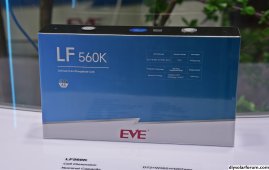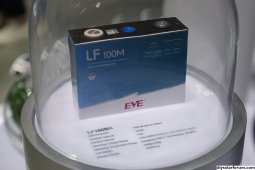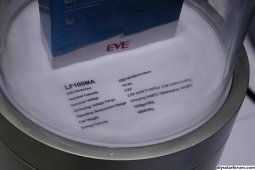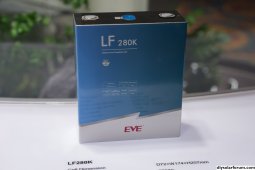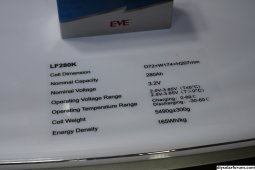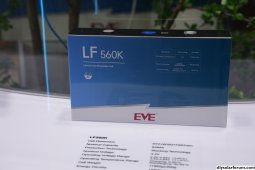You are using an out of date browser. It may not display this or other websites correctly.
You should upgrade or use an alternative browser.
You should upgrade or use an alternative browser.
New EVE Cell at RE+ 2023: LF 560K (628Ah Cell)
- Thread starter Will Prowse
- Start date
hwy17
Anti-Solar Enthusiast
As a newcomer to the diy batteries right now, I would like to join in for the 560 era.
I am trying out different BMS first on a 100 pack, and there's a lot of support for multi packs here but long term I'm leaning towards as large of a single pack as I can. This would save me having to consider 2p.
Anyone notice the little badge says 628ah? Oh yeah right there in the specs too. 32kwh 16s.
I am trying out different BMS first on a 100 pack, and there's a lot of support for multi packs here but long term I'm leaning towards as large of a single pack as I can. This would save me having to consider 2p.
Anyone notice the little badge says 628ah? Oh yeah right there in the specs too. 32kwh 16s.
Last edited:
Interesting, thanks.
My 2 thoughts...
a) why have they changed the naming convention - LF560K makes no sense for a 628Ah cell?
B) the energy density is hardly any better than the LF280K and worse than the LF306K. So, unless it's a lot cheaper per Ah, I'd go for 2 of the 306's instead.
My 2 thoughts...
a) why have they changed the naming convention - LF560K makes no sense for a 628Ah cell?
B) the energy density is hardly any better than the LF280K and worse than the LF306K. So, unless it's a lot cheaper per Ah, I'd go for 2 of the 306's instead.
tim0shel
Solar Enthusiast
- Joined
- Jan 27, 2020
- Messages
- 464
Very good points I was looking at it but did not do the math or compare to their current batteries.Interesting, thanks.
My 2 thoughts...
a) why have they changed the naming convention - LF560K makes no sense for a 628Ah cell?
B) the energy density is hardly any better than the LF280K and worse than the LF306K. So, unless it's a lot cheaper per Ah, I'd go for 2 of the 306's instead.
zcskywire2
Solar Enthusiast
Interesting, thanks.
My 2 thoughts...
a) why have they changed the naming convention - LF560K makes no sense for a 628Ah cell?
B) the energy density is hardly any better than the LF280K and worse than the LF306K. So, unless it's a lot cheaper per Ah, I'd go for 2 of the 306's instead.
A, they upped the capacity during trial production, when they announced it, it was 560ah. Really when you look at the dimensions and the specs it was a double LF280k cell, now it's a double 314 ah cell. If I had to guess it's to better compete with vision battery which announced a 580ah cell after the original LF560K launch
B, By mass density yes it is worse but for the target ESS market it's more volume rather than weight that matters. This version of the LF560K has a higher volumetric density than both the LF280K and LF306K. Now I do know EVE has a 314ah range cell in the works that's the same size as a LF280k but no time frames or further details. Also the K indicates a stacking rather than wound cell.
Edit: a lot of bad grammar cleaned up, this is what I get for staying up for 24 hrs
True... but only 1.4% higher volumetric density than the LF306K, so somewhat marginal. Fingers crossed it will be much cheaper.B, By mass density yes it is worse but for the target ESS market it's more volume rather than weight that matters. This version of the LF560K has a higher volumetric density than both the LF280K and LF306K.
OffGridForGood
Catch, make or grow everything you can.
C) Discharge to -30 (!!!) - Finally a LiFePO4 cell that is Canada-Friendly! (ok only southern Canada, but it's a good start).Interesting, thanks.
My 2 thoughts...
a) why have they changed the naming convention - LF560K makes no sense for a 628Ah cell?
B) the energy density is hardly any better than the LF280K and worse than the LF306K. So, unless it's a lot cheaper per Ah, I'd go for 2 of the 306's instead.
{Are we not limited to basically 0-degrees C (charge or discharge) on current EVE 280Ah/304Ah cells?}
timselectric
If I can do it, you can do it.
- Joined
- Feb 5, 2022
- Messages
- 19,055
More options are always a good thing.
No. Have always been able to discharge at < 0. The LF280 and LF304 cells shown above also say -30C.C) Discharge to -30 (!!!) - Finally a LiFePO4 cell that is Canada-Friendly! (ok only southern Canada, but it's a good start).
{Are we not limited to basically 0-degrees C (charge or discharge) on current EVE 280Ah/304Ah cells?}
OffGridForGood
Catch, make or grow everything you can.
Interesting,No. Have always been able to discharge at < 0. The LF280 and LF304 cells shown above also say -30C.
I don't recall seeing discharge allowed down to these temps before.
Maybe I just missed it.
D) What about these upper temperature limits 60-degrees C (140F) - there were some lab-test postings a while back that showed massive cell degradation at high temps, even in the 40-degree range. Makes me wonder if they have changed the chemistry to accept wider operating range - ie for EV use in wider temperature ranges.
zcskywire2
Solar Enthusiast
D) What about these upper temperature limits 60-degrees C (140F) - there were some lab-test postings a while back that showed massive cell degradation at high temps, even in the 40-degree range.
There is a large cycle life degradation even at 45C. EVE directly puts it in the datasheets. Normally it's around a 50% reduction in cell like span. For the LF280K it is 6000 cycles at 25c and 2500 cycles at 45c
That 60C operation temperature is that maximum discharge temperature before possible cell failure. The degration at that temperature is very high but the cells will work continuously there. Above that you will likely blow a cell safety. Likely a fuse but I'm not exactly sure what. I've tested some cyclindircal cells at 60C and higher and ~50% of the cells blew their safety when cycled above 60c.
OffGridForGood
Catch, make or grow everything you can.
This is excellent information, thanks.There is a large cycle life degradation even at 45C. EVE directly puts it in the datasheets. Normally it's around a 50% reduction in cell like span. For the LF280K it is 6000 cycles at 25c and 2500 cycles at 45c
That 60C operation temperature is that maximum discharge temperature before possible cell failure. The degration at that temperature is very high but the cells will work continuously there. Above that you will likely blow a cell safety. Likely a fuse but I'm not exactly sure what. I've tested some cyclindircal cells at 60C and higher and ~50% of the cells blew their safety when cycled above 60c.
My main Solar ESS operates year-round in a range of 14-21 degrees C, however I have a remote cabin where I bring my portable MPP 2724 and one or two 304Ah (8S) batteries with me each time I visit. I have been musing about a stationary set up for the cabin, but there is no heating source while I am away. Leads to my interest in cells that can operate in low temperatures like -30C. (no, I don't want AGM, been there).
As @SeaGal pointed out, the LiFePO4 cells have always allowed discharge below freezing, but not charging.
My thought is: charging available means solar is available means a heating pad could be used to warm just the battery compartment, above zero-C first, then charging can begin safely. A simple set up with temperture activated relays or Arduino could control it all, build the cabin batteries to fit inside a well insulated box with heating pads running directly from DC on solar type of thing.
timselectric
If I can do it, you can do it.
- Joined
- Feb 5, 2022
- Messages
- 19,055
A pre maid battery with heating option, works this way.
When the temperature is below the setpoint. Charging input is directed to the heating pad, instead of the cells. Until the temperature reaches the safe level. Then the BMS switches from heating to Charging.
When the temperature is below the setpoint. Charging input is directed to the heating pad, instead of the cells. Until the temperature reaches the safe level. Then the BMS switches from heating to Charging.
OffGridForGood
Catch, make or grow everything you can.
Does the pre-made battery use it's own stored energy to run the heating pad/maintain temperature set point? - ie even at night when there is no chance for solar input (charging) this would be a waste of the available energy since the battery is capable of output at low temps, just not input/charging.A pre maid battery with heating option, works this way.
When the temperature is below the setpoint. Charging input is directed to the heating pad, instead of the cells. Until the temperature reaches the safe level. Then the BMS switches from heating to Charging.
timselectric
If I can do it, you can do it.
- Joined
- Feb 5, 2022
- Messages
- 19,055
NoDoes the pre-made battery use it's own stored energy to run the heating pad/maintain temperature set point? - ie even at night when there is no chance for solar input (charging) this would be a waste of the available energy since the battery is capable of output at low temps, just not input/charging.
The heating pad is only powered by the charging input. Discharging in cold temperatures is not an issue.
zcskywire2
Solar Enthusiast
I have been musing about a stationary set up for the cabin, but there is no heating source while I am away. Leads to my interest in cells that can operate in low temperatures like -30C.
My thought is: charging available means solar is available means a heating pad could be used to warm just the battery compartment, above zero-C first, then charging can begin safely. A simple set up with temperture activated relays or Arduino could control it all, build the cabin batteries to fit inside a well insulated box with heating pads running directly from DC on solar type of thing.
If you wanted to DIY it, the heating pad idea should work. I do think though there are JBD or JK BMS units with built in heater controls, this way you wouldn't need all the extra Arduino logic.
If you more wanted cells that operate below freezing (not necessarily -30c) there are a few options. First up would be cold weather LFP cells. I've really only seen them as cyclindircal 26650s right now but they may exist in prismatics. CBAK and BST make ones that charge down to -20C. Having tested the BST ones, they absolutely spank regular LFP cells in the cold, both in usable capacity and charge abilities. The major downside is the total capacity of the cells are lower. The BST ones are 3.35Ah while a high density LFP cell will hit 4Ah. Granted at -20C you won't get anything really out of the 4Ah cell, were as you'll likely get 3+ Ah out of the cold weather cell. If you are interested in them you can search BST G2W and CBAK 26650LT or 26700LT
The upcoming sodium ion cells all are supposed to charge down to -20C while retaining up to 95% discharge at -40C. They really are that available yet but they will be coming in the traditional 71173207 form factor. Biggest problem will be the large voltage range of the cells from ~2v-4v which means they may end up out of the voltage range of an inverter. Also they would require a programmable BMS as custom programed Sodium Ion BMSs aren't a thing yet
If you truly wanted a -30C unmonitored cell LTO cells are really your only option. LTO cells are 80%+ chargeable at -20c, and 60%+ chargeable at -40c. That means at -40c you can get 60+% nameplate capacity in and out of the cell. This is way beyond what any other chemistry can deliver at that temperature. They also deliver extremely high c rates in charge and discharge, often exceeding 10c. Cell life can often exceed 20K cycles as well. The tradeoffs being cost and space. LTO cells generally have 1/2 the energy density of LFP cells. A 71173207 format LTO cells is only 414wh vs the 896-1104wh of a LFP cell. They also have a lower cell voltage of 2.3-2.5v nominal requiring more cells to make a 48v pack, typically 20s or 21s for LTO vs 16s for LFP. The chemistry is also more expensive to manufacturer due to the materials used. If you wanted the there are a few manufacturers out there that make them such as gree (formerly yinlong) , shenquan and others as well as custom BMS units from companies such as daly for them.
OffGridForGood
Catch, make or grow everything you can.
Great info, thanks for all the comments.
I have considered the LTO cells in the past, but the cost was so high I concluded heating pads and control was the better option. At the time, the only source for the LTO cells I looked at was Battery Hookup, do you think the cost for cells will be much better from Shenquan/Chinese vendors Alibaba?
I have considered the LTO cells in the past, but the cost was so high I concluded heating pads and control was the better option. At the time, the only source for the LTO cells I looked at was Battery Hookup, do you think the cost for cells will be much better from Shenquan/Chinese vendors Alibaba?
zcskywire2
Solar Enthusiast
Great info, thanks for all the comments.
I have considered the LTO cells in the past, but the cost was so high I concluded heating pads and control was the better option. At the time, the only source for the LTO cells I looked at was Battery Hookup, do you think the cost for cells will be much better from Shenquan/Chinese vendors Alibaba?
Probably not any different, I did just take a quick look on alibaba. Yinlongs are ~30-40$ for cells but chances are most all are used. Vendors like to also mess with the ratings as yinlongs come from 25-45ah in the same form factor. I've started to see some of the new Gree production 155ah 71135207 cells show up from around $200 as well. Shenquans were $51 for 30ah cells, brand new. Tianjin plannano, another manufacturer had 35ah cells for $40 new from factory. Regital has a LTO cell lineup as well but they don't sell on Alibaba so I haven't got any pricing information on them. I did however talk with them at RE+ so that may change soon.
timselectric
If I can do it, you can do it.
- Joined
- Feb 5, 2022
- Messages
- 19,055
If building a DIY battery.
I know that some JK BMS versions offer the heating controls. You just have to source the pad.
I know that some JK BMS versions offer the heating controls. You just have to source the pad.
Similar threads
- Replies
- 113
- Views
- 9K
- Replies
- 9
- Views
- 741
- Replies
- 11
- Views
- 1K
- Replies
- 2
- Views
- 528



